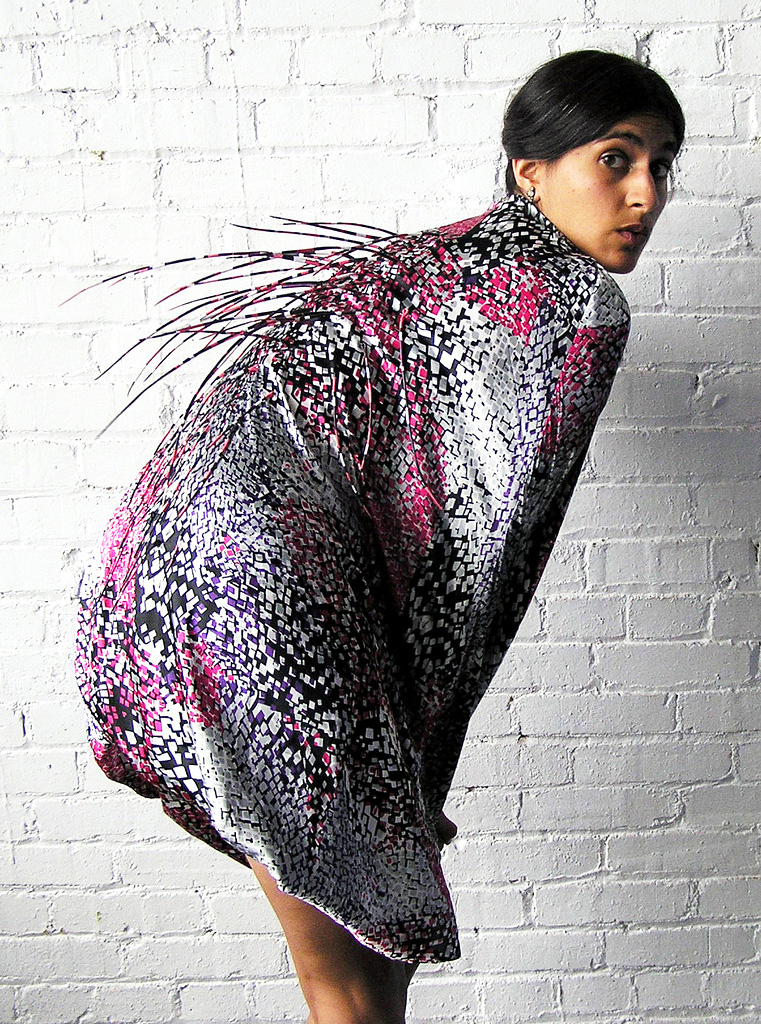Designer Amisha Gadani derives inspiration for her defensive dresses from studying animals

Amisha Gadani shows off a porcupine dress, one of her designs. Gadani gets inspiration for dresses as she studies animals and their physiology in UCLA’s Alfaro Lab.
By Colin Reid
Feb. 1, 2012 12:48 a.m.
Correction: The original version of the photo caption for this article contained an error. Amisha Gadani is the model in the photo.
Humans aren’t equipped with many natural defenses. They don’t blend into a wall or emit a cloud of smoke. They don’t grow in size or produce spikes when frightened. Humans are incapable of these feats; that is, when they aren’t wearing one of Amisha Gadani’s many defensive dresses.
Having received her bachelor’s degree in visual arts at Carnegie Mellon University in Pittsburgh, Gadani now works in the Alfaro Lab at UCLA studying animals and their physiology.
Using this scientific knowledge, she combines her love of art and science to create cocktail dresses that double as animal-inspired defensive gowns, much like a James Bond gadget straight out of Q’s lab.
Today, Gadani will be speaking to UCLA students about her work process and how she came to be in this novel situation.
The intertwining of art and science may seem like an alien prospect, but Gadani said she sees it as a natural fusion of disciplines.
Her interest in the two fields began at a young age, where she and her family watched NOVA, a science-oriented television special hosted by PBS.
“I think my home environment helped me to stay curious about the natural world and why things work the way they do or look the way they do,” Gadani said.
She also said that, as a child, she would explore her large backyard, an environmental expedition that led her to the work she creates today.
Gadani’s favorite piece that she’s created is dubbed the “Porcupine Dress.” When threatened, the wearer simply bends over, exposing more than 30 oven-baked needles that are intended to intimidate and scare off the attacker.
Other dresses use more sophisticated methods, sometimes incorporating mechanical devices that Gadani makes herself.
Such projects include the “Cuttlefish Dress” that releases ink-like helium balloons when the wearer’s arms are raised, and the “Blowfish Dress,” a garment that inflates through the use of kinetic touch when the wearer’s fists are clenched as if readying for a fight.
Gadani’s co-worker at the Alfaro Lab, Tina Marcroft, is a doctoral student in ecology and environmental biology, but her studies haven’t stopped her from noticing Gadani’s unusual projects.
“I haven’t really seen anything like it, personally. I have a big interest in some of the clothing aspects of her design and how she puts together some of the scientific and artistic aspects,” Marcroft said.
Outside of the lab, Gadani spends her time assisting elementary school students, teaching them scientific concepts with the help of her visually pleasing, yet educational artistic pieces.
“She’s been working with us to do some outreach to fifth graders, coming up with ways to convey ideas about macroevolution and biodiversity to the elementary school kids,” said Michael Alfaro, principal investigator at Gadani’s lab.
While satisfied with her current situation, Gadani said her true passion lies out at sea.
“I would really love to be on a research boat in the middle of the ocean. I want to be learning about new species and studying marine animals,” she said.
This dream is in conjunction with what she will be discussing during her lecture.
Gadani said she hopes to inspire art students to branch out within their chosen art form.
“A lot of friends that I knew in college went and became art handlers or they worked at a gallery. I personally don’t feel that’s the best use of your degree. There are all these things you can do,” she said.
Accompanying her well wishes is a warning in good faith, formed from experience.
“There’s no path for an artist,” Gadani said. “Unless you want to be an art educator, there’s no system.”
But Gadani found her own way, and so can other aspiring artists, perhaps with the help of a little fabric and small electronics.

